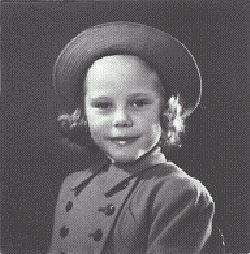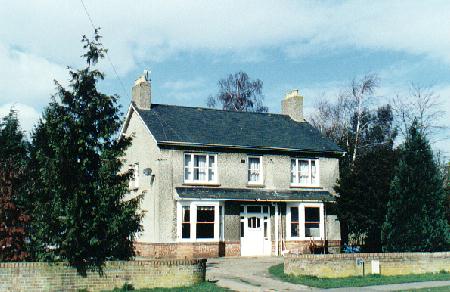|

A
Polyfoto taken at Peterborough in 1941
of Christina Backman, aged
eight, in best
pea-green coat and hat. |
An
Alien
in
the House
by
CHRISTINA BACKMAN
|
During the
1930s, it was quite possible for a Swedish family to live for years in London and never enter the house of a native Englishman. The 1940
blitz changed all that. Whereas before the war, our only friends had been Swedes living in London, we were now to become part of the Wilson
household as evacuees in Bourne. We were all to find out how the other half lived.
The arrangement was that as we boarded with the Wilsons, we now had afternoon tea instead of the coffee and cakes which is usual in Swedish circles. I can vividly remember being introduced to such British delicacies as sandwiches with marmite and lettuce or watercress or various kinds of
fish paste from little fluted glass jars. Toast was made with a brass toasting fork at the coal fire. There was even the occasional roast beef
with Yorkshire pudding. Christmas brought mince pies and a fat spicy pudding.
In those days of rationing, you needed to pool your resources and above all to be resourceful. Swedes drink coffee and this was not rationed. My
parents' unused tea coupons could therefore be bartered for butter or bacon or even extra meat. Both my mother and George Wilson were good providers. Uncle George took us on an outing to a golf course not far from Burghley House. It was autumn, and occasional shots could be heard from some aristocratic shooting party. Suddenly, a fat cock pheasant fell out of an empty sky at our feet. Quick as lightening, George emptied his golf bag of clubs, dropped the bird in and put the clubs back with a heaven sent addition to the kitchen stores! My mother, although her English was not very good, used to tramp around the flat Lincolnshire countryside, calling at the farms to see if they had any eggs for sale. Quite often they had. These eggs were then preserved in great zinc buckets with lids and filled with isinglass and were eventually lugged back with us on the train to London where they eked out our meagre egg rations for quite some time.
Swedes spend the latter half of the summer in the forests, picking bilberries and mushrooms. In Bourne, we gathered blackberries instead
and many a pot of jam also travelled by train to London to supplement the tinned Victoria plum jam which was usually all there was in the shops.
Brown cows grazed in Mason´s field behind Woodland Lodge, the Wilson´s home in North Road. Daisies and buttercups grew here and so, my delighted parents discovered, did field mushrooms. Perhaps it was not usual to pick them in Bourne in those days as I remember my parents had to work hard to overcome Elsie Wilson´s reluctance to prepare them for our dinner.
|
 |
Woodland
Lodge, the Wilson family home at No
103 North Road,
Bourne, where Christina
was
evacuated
in 1940.
|
In summer, when the weather was hot and before the days when milk was homogenized, Swedes would set it in little bowls to make a kind of
yoghurt which we called sour-milk. The sunny afternoon when my parents each took a bowl of snow-white creamy sour- milk into the Wilsons´garden,
sat down in deckchairs under the apple-trees, shook some sugar and powdered ginger onto the dish and spooned it up with obvious relish, is
fresh in my memory. The Wilson family stood marvelling around to watch the spectacle of crazy foreigners actually eating sour milk with every
sign of enjoyment. Now of course yoghourt is part of the staple British diet.
The two winters we spent in Bourne were exceptionally cold throughout Europe. We Swedes were fully equipped to deal with the snow and ice
outdoors. I had a navy blue woollen skiing suit, rather like Winston Churchill's boiler or siren suit, with a matching close fitting cap and gaily
patterned knitted mitts. However, we were by no means prepared for the Arctic conditions in the bedrooms of those who at that time knew neither
double-glazing nor central heating. This was when we learned to use and
cherish the British hot water bottle but going to bed was like preparing for a trip to the North Pole. We did not undress, we dressed. A woolly vest
went under nightie or pyjamas, a sturdy cardigan on top and long woollen socks on the feet. Our eiderdowns (duvets) came with us from London and
went on top of our blankets. My mother owned a fur coat which also came in
useful. Though small, nobody could say our bedroom was stuffy.
Christmas 1940 is one I shall never forget. We had the best of two worlds.
Swedes celebrate on Christmas Eve and my parents had prepared a Swedish Christmas for all of us. That night, a very English pillowcase was hung
on the end of my bed. During the night, Santa Claus filled it. Among my presents was a little doll, dressed in RAF uniform, that was promptly
christened Ted in honour of Ted Wilson, the son of the house who had been
called up for military service and was serving as an airman. We all sat down to Christmas dinner together, pulling crackers and wearing fancy paper hats. To us, it was exotic. Fancy putting coins in your pudding!
By December 1941, things were quieter on the Home Front and my mother and I returned to London for Christmas. This was not altogether simple. As
aliens, my parents were required to carry Certificates of Registration and
to request permission whenever they went anywhere. Thus, in October 1940, the Hull City police permitted my mother to visit "the Lincolnshire and Yorkshire Protected Area until further notice" and the Metropolitan
Police in Hammersmith noted that on 2nd December 1941, she was back in London "on a visit". My father
was working for the BBC and this apparently entailed him being "approved for employment in auxiliary war services" and exempt "from Article 1 of the Aliens (Movement Restriction) Order and consequently did not have to request permission every time he wanted to visit us in Bourne.
It was sheer delight being a child in Bourne with the countryside all around.
There were new games to be learned. For instance, in London we had not played with whips and tops. In Bourne, coloured chalks were used on the
flat upper side to make a pattern when the top was spun. French knitting, where you rammed four nails into a cotton reel and
"knitted" a long woollen snake through the hole in the middle, was also much in vogue. Knitting wool was on coupons but you could still buy skeins
of gaily coloured mending wool from a little shop in the Market Place. And then of course, you could dress up. An imaginative seven-year-old, I
had borrowed my mother's flowered summer dress, her large black handbag and her high heeled shoes and was happily parading up and down North Road outside Woodland Lodge when a lady stopped and rather hesitatingly spoke a few words to me before entering the house. A relation of the Wilsons had arrived for a visit and she confessed to them that those foreigners seemed
alright but added: "Don't they dress their children strangely!"
We learned how the other half lived. I went to Miss Close´s little school in Elm Terrace and my mother did her bit for the war effort. George Wilson worked in the local Food Office where new ration books were issued every so often. At his suggestion, my mother was roped in to help write up and distribute new ration books and
"pink points coupon" books that were used for special foods such as biscuits and tinned fruit, when available. The letter thanking her and assuring her "that we are all extremely grateful for your voluntary service" is still treasured. Perhaps we weren't so very different after all.
See also
An Alien in the Classroom
Contributed in June 2002 by Christina Backman of Uppsala, Sweden
Email: Backman.fm@telia.com

Go to:
Main Index Villages
Index
|

